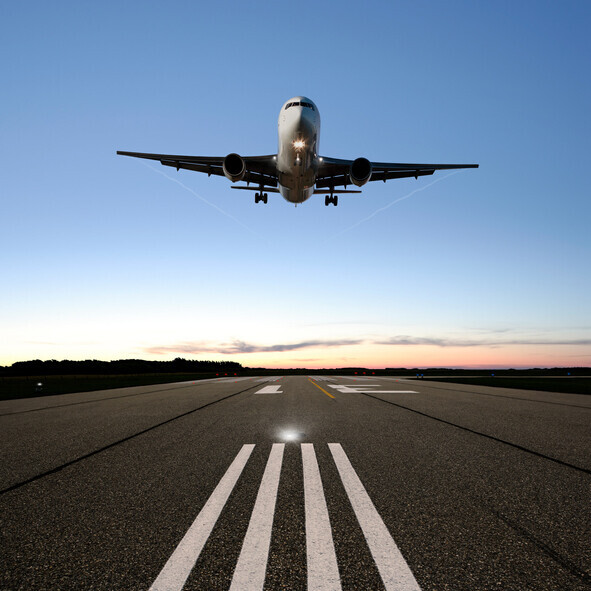hankyoreh
Links to other country sites 다른 나라 사이트 링크
Destination climate change: non-landing flights fuel greenhouse gas emissions

Non-landing flights where passengers fly around without stopping at any destination are scheduled to expand throughout South Korea as of next month.
It’s a self-rescue measure by the airline industry to stay afloat during the COVID-19 pandemic, based on the travel demand it has perceived among consumers.
The Ministry of Land, Infrastructure and Transport (MOLIT) announced on April 19 that it will be expanding the non-landing tourism flights — which began at Incheon International Airport in December 2020 — to other local airports in Gimpo, Gimhae, Daegu and elsewhere as of next month.
Around three flights a day will be offered per airport. Asiana Airlines has already been offering a package where passengers depart from Incheon and fly over Busan, Fukuoka and Jeju before returning to Incheon.
Jeju Air has similarly offered a package where flights take off from Incheon or Gimpo, traveling over Busan and Daema Island before passing back over Busan and returning to Incheon or Gimpo.
Consumers starved for overseas travel and duty-free shopping have been welcoming the non-landing flight packages. But environmental groups and experts have argued that it undercuts the response to the climate crisis to have greenhouse gas-heavy aircraft flying the skies even when there is no demand for overseas travel.
The Hankyoreh compared carbon emissions from aircraft, trains and automobiles. An analysis by the European Environment Agency concluded that an aircraft carrying 88 people emits 285 grams of carbon per passenger per kilometer, citing 2014 figures from the Transformative Urban Mobility Initiative, a group working toward sustainable transportation.
An automobile carrying 1.5 passengers emits 158 grams traveling the same distance, while a train carrying passengers emits 14 grams, the study showed.
An airplane emits far more carbon when it is taking off than when it is flying at high altitudes. The emissions also increase with the amount of weight carried by the aircraft. Per capita carbon emissions are three to four times higher for passengers sitting in spacious and comfortable first class or business class seats than for passengers packed together in economy.

It is for this reason that criticisms have focused less on emission from long-distance flights — where there is often no clear alternative means of transportation — than on those generated from short-haul flights where other options such as trains are available, or on non-landing flights that merely circle the skies without landing at a specific destination.
A one-way journey between Incheon and Fukuoka amounts to 562 kilometers. Asiana’s non-landing round-trip flight from Incheon to Busan, Fukuoka, Jeju and back to Incheon covers an equivalent distance — 1,263 kilometers — to a one-way flight from London to Madrid.
The service EcoPassenger, which calculates the carbon footprint associated with different means of transportation, was used to compare anticipated carbon emissions for this package.
A one-way flight from London to Madrid was estimated to generate 118 kilograms of carbon per passenger — and 265 kilograms of carbon plus other greenhouse gases. A train traveling the same distance would emit 43 kilograms of carbon per passenger.
Internationally, the trend has been toward reducing the use of aircraft to cut down on greenhouse gas emissions in response to the climate crisis. On April 10, the French National Assembly approved legislation that would ban the operation of domestic air service over short-haul distances that could be traveled in under two-and-a-half hours by train. In Sweden, a “flygskam” (“flight shame”) campaign has been underway since 2017 to urge people to use trains and other means of transportation besides aircraft.
The airline industry insists that it has no other options available to get through the current situation with opportunities for overseas travel blocked.
According to MOLIT figures, around 8,000 passengers flew on non-landing flights offered by airlines based in seven different countries between December 2020 and March 2021. The argument is that this demand contributes to increasing sales and maintaining employment in related industries.
Another issue is the pilots’ need to fulfill their flying time requirements. According to the enforcement decree for South Korea’s Aviation Security Act, pilots must experience three or more takeoffs and landings with their corresponding aircraft within a 90-day period.

Germany’s Lufthansa, one of the world’s largest airlines, announced on April 19 that it would be increasing the carbon-neutrality of its flights through a platform known as Compensaid.
A digital CO2 compensation platform set up by Lufthansa, Compensaid shares CO2 emissions totals for travelers who enter their flight information and guides them to take part in offset programs. Flight-related emissions can be offset by tree planting and other climate protection projects, as well as the use of sustainable aircraft fuel.
Passengers who take part in the program receive a certificate that they can share on social media to show that their flight is nothing to feel “shame” over.
By Kim Min-je, staff reporter
Please direct comments or questions to [english@hani.co.kr]

Editorial・opinion
![[Column] Life on our Trisolaris [Column] Life on our Trisolaris](https://flexible.img.hani.co.kr/flexible/normal/500/300/imgdb/original/2024/0505/4817148682278544.jpg) [Column] Life on our Trisolaris
[Column] Life on our Trisolaris![[Editorial] Penalties for airing allegations against Korea’s first lady endanger free press [Editorial] Penalties for airing allegations against Korea’s first lady endanger free press](https://flexible.img.hani.co.kr/flexible/normal/500/300/imgdb/original/2024/0502/1817146398095106.jpg) [Editorial] Penalties for airing allegations against Korea’s first lady endanger free press
[Editorial] Penalties for airing allegations against Korea’s first lady endanger free press- [Editorial] Yoon must halt procurement of SM-3 interceptor missiles
- [Guest essay] Maybe Korea’s rapid population decline is an opportunity, not a crisis
- [Column] Can Yoon steer diplomacy with Russia, China back on track?
- [Column] Season 2 of special prosecutor probe may be coming to Korea soon
- [Column] Park Geun-hye déjà vu in Yoon Suk-yeol
- [Editorial] New weight of N. Korea’s nuclear threats makes dialogue all the more urgent
- [Guest essay] The real reason Korea’s new right wants to dub Rhee a founding father
- [Column] ‘Choson’: Is it time we start referring to N. Korea in its own terms?
Most viewed articles
- 1New sex-ed guidelines forbid teaching about homosexuality
- 260% of young Koreans see no need to have kids after marriage
- 3Months and months of overdue wages are pushing migrant workers in Korea into debt
- 4Presidential office warns of veto in response to opposition passing special counsel probe act
- 5[Column] Life on our Trisolaris
- 6S. Korea discusses participation in defense development with AUKUS alliance
- 7OECD upgrades Korea’s growth forecast from 2.2% to 2.6%
- 8Hybe-Ador dispute shines light on pervasive issues behind K-pop’s tidy facade
- 9Japan says it’s not pressuring Naver to sell Line, but Korean insiders say otherwise
- 10Opposition calling for thorough investigation into Pres. Park’s unelected power broker